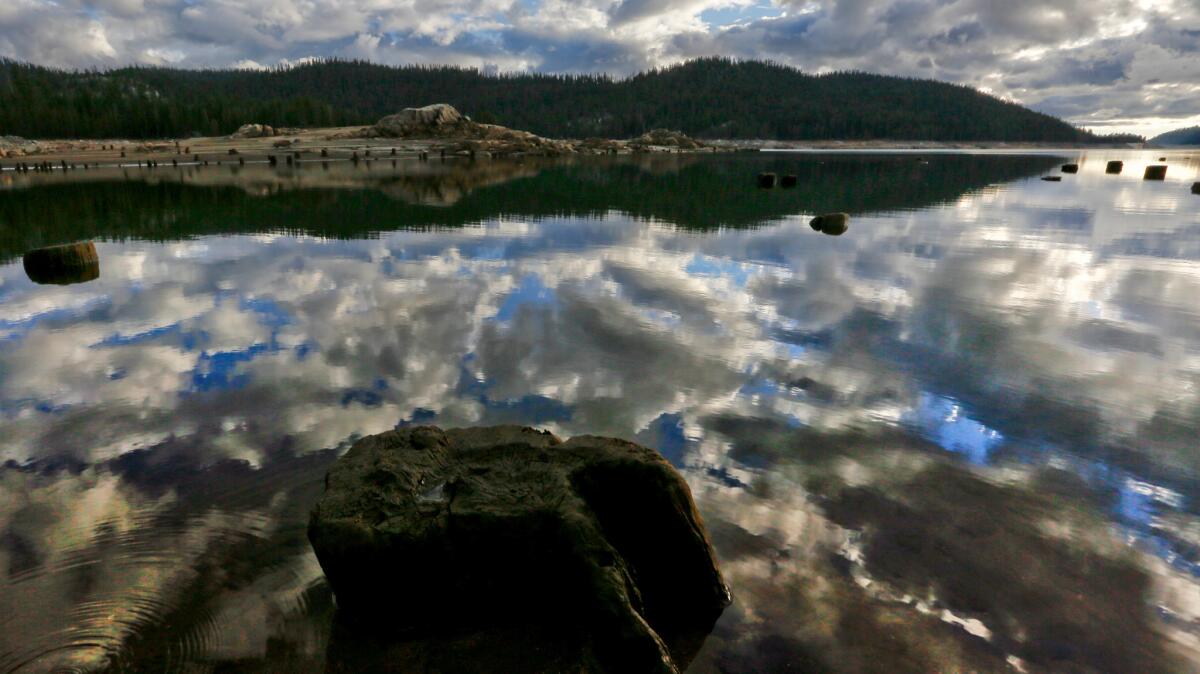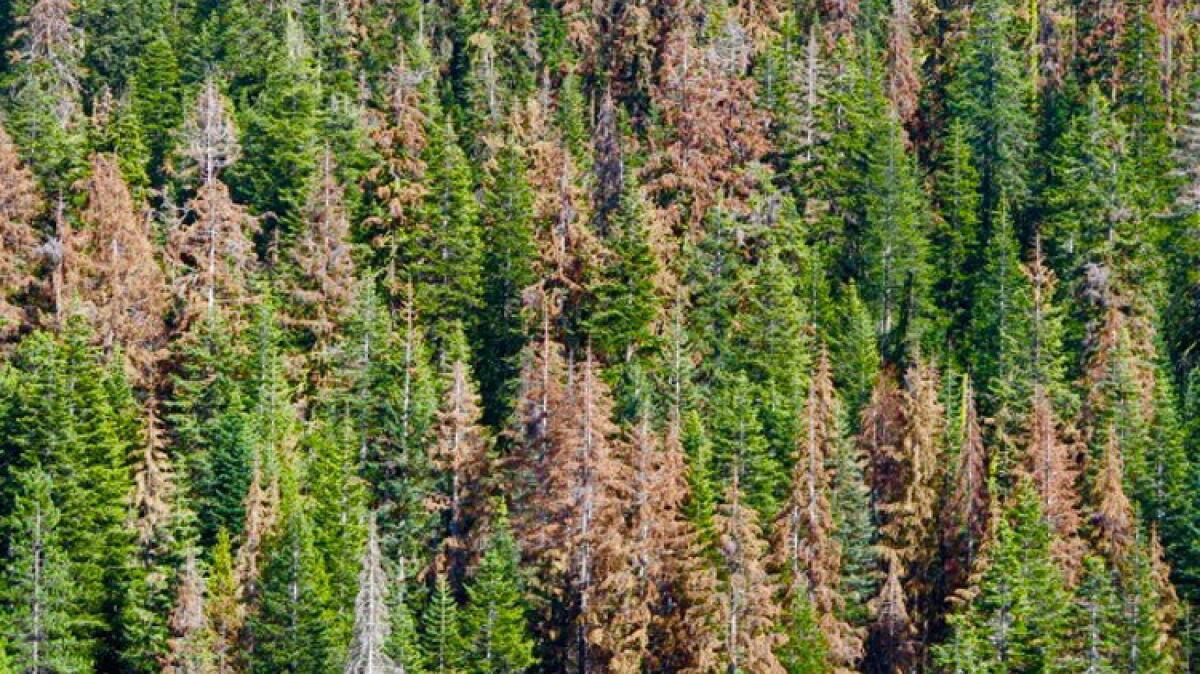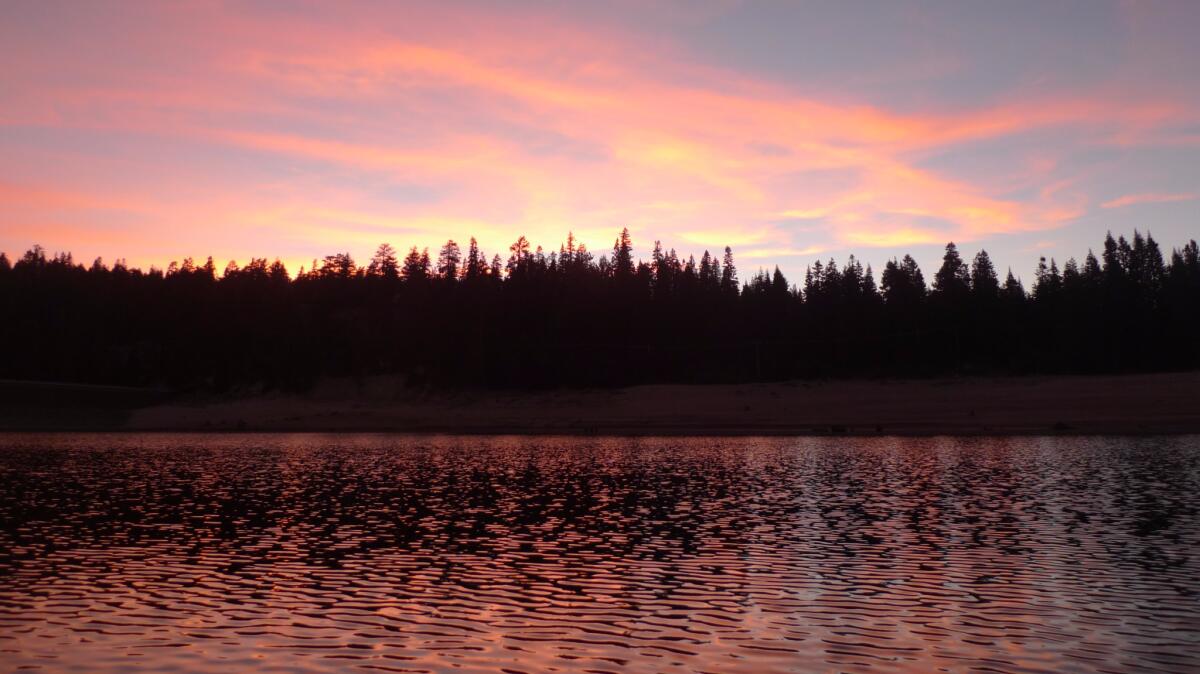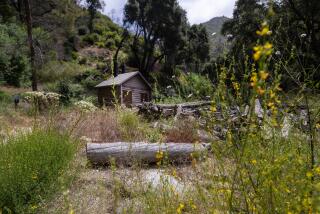The High Sierra forest is dying, and you can’t count the loss in dead trees
Reporting from Huntington Lake, Calif. — Some years ago — almost 20, actually — my wife and I made it a habit to leave the city in August and head for the High Sierra. Our destination has always been a lake edged by cabins, 60 miles east of Fresno, just south of Yosemite and just north of Sequoia.
We’re gone for only a week, but that hardly matters. Time in the mountains, at the height of summer, has the languidness of taffy, folded and pulled so the minutes and hours blur into one another. Sometimes days seem best measured by the scavenging of stellar jays and chipmunks in the morning and the blaze of campfires at night.
Summer is a brief season at Huntington Lake. The cabins open in May. They close in October, and, summer to summer, they host scores of families, generations drawn to the elemental pleasures of sunlight, water and pines.
Weeks drift by with no great urgency, and the stakes for the most ambitious plan — catch a trout, discover a backcountry lake, finish a book, avoid getting sunburned while eating an ice cream on the dock — are always conditional.
Such routines are best practiced, I believe, in a place where timelessness and changelessness are easily confused, which perhaps explains why our recent trips have been so difficult.

In 2014, the path to the lake crossed a desert of once-submerged sand and suddenly wayward docks. The drought had left its mark. Dust devils whipped a moonscape, dotted with tree trunks and the debris from when the dams were built to form this lake more than 100 years ago. Lost fishing lures glinted in the sun.
In 2015 the drawdown was rumored to be worse — we made other plans — but with lake levels back to normal, we returned this summer, expecting to find our getaway as it has always been. It was, and it wasn’t.
We first noticed the trees about half an hour out of Fresno where the highway turns into a two-lane road winding past estates and ranches before beginning its long and gradual ascent into the high country.
Ahead were vantages of the forest, its green array mottled silver and brown, discordant colors that grew sharper and more defined the closer we got. Driving through corridors cut through the woods by the road, we found sunlight where there had once been shadows. Logs lay on the shoulder, stripped and sectioned, ready to be hauled.
Trees are dying. I know that. I have written about them, and I have seen their skeletons in the parkways and golf courses, the freeway cloverleafs and cemeteries back home. But nothing was as dramatic as what we now saw.

At 7,000 feet, we rolled down the windows. A sweet balsam scent flooded the car, and within an hour we arrived at the lake and were settling in, the ease of vacation tinged with an unfamiliar regret. This was less a reunion than a recognition that something was slipping away that could not be recovered.
Nostalgia is an awkward sentiment for anyone who views these mountains as a dynamic and ever-changing landscape shaped by seismic uplift and modeled by storms and fires. But climate change and its horsemen — rising temperatures, drought and bark beetle — are accelerating this pace.
The reports have been out for more than a year and continue to be revised. An ecologist for the U.S. Geological Survey tells me that one well-studied plot in Yosemite, which has been experiencing a 2% annual loss in its trees, this year has seen more than a 20% die off. Another researcher reminded me that predictions of tree mortality in the state are heading upward, toward 66 million.
But the numbers, as stunning as they are, feel like abstractions, the world viewed through the wrong end of a telescope. They fail to communicate the meaning of this loss, and at a time when the distance between wilderness and city needs most to be bridged, they only add to the growing estrangement.
That week, sitting on the cabin’s porch, walking the trails, swimming in the lake, I looked in vain for a more intimate language to express what we were seeing. I thought of the Inuit of Baffin Island who refer to changing weather patterns in their region as uggianaqtuq, a friend acting strangely.
So I turned to words other than brown — russet, auburn, burnt, toast — to describe the forest’s new color. I sketched in my mind the disposition of the trees, whose once-uplifted boughs now sagged. I wondered how long before the wolf lichen, the only green on some, would fade.
I turned to words other than brown — russet, auburn, burnt, toast — to describe the forest’s new color.
On the trail one afternoon, I touched the branch of a pine. Its brown needles — still as thick as a shaving brush, as if it had been alive just yesterday — broke off in my hand, brittle and crisp, scorched and desiccated. In the absence of water, I have been told, a tree’s pores close, starving it of carbon dioxide. Come the first autumn storm, and an apron of needles will surround this trunk.
I tried to imagine a repair, like the lake filling with water again, but it was not possible. Ridgelines will grow more open, campsites warmer, and our favorite trees, landmarks on these trails, will fall or burn.
Change is inevitable. Antarctica was once covered by a forest that was probably a magnificent ecosystem, and the Sierra was once under the sea. But that perspective — grains of sand in geologic time — offers little solace. The dying trees, stippling these slopes, threaten what I want to take for granted, a refuge of sorts providing continuity beyond the commotion of urban life.

I have relished walking among the stars in these mountains, feeling the subtle shift of the seasons, the crunch of dirt beneath my feet, a constancy that will neither alter nor disappear. When the wind patterns the lake, clouds tumble overhead or a deer crosses our path, I think I have glimpsed something eternal, even when I know it’s a lie.
But now these mountains and this man-made lake have been caught up in the fray, and the historic battles to preserve this vast wilderness, first joined when John Muir called these peaks home, will be lost with no clear villain in sight, no corporation, water company or public utility.
At the end of our week this summer, we felt a deeper regret for leaving, as if we were walking away from a friend. Our time at the lake had passed quickly, and we wondered what we would find next year, even when we knew the answer.
A researcher recently told me, “At any given moment you can find new trees that are just starting to die, so we haven’t seen the end of it yet. With luck, things will start settling down.”
The afternoon we left the lake, we didn’t feel lucky. We drove out of the mountains into the Central Valley, and the sky was thick with the smoke from the fire in Big Sur and a new one near San Simeon. The sun was a circle of light masked by red cellophane. Some other sere landscape was ablaze.
Twitter: @tcurwen
ALSO
Confronting our history and ‘unspeakable acts’ at the site of the Sand Creek Massacre
Roaming San Francisco Haight Ashbury aboard a Magic Bus
More to Read
Sign up for The Wild
We’ll help you find the best places to hike, bike and run, as well as the perfect silent spots for meditation and yoga.
You may occasionally receive promotional content from the Los Angeles Times.







